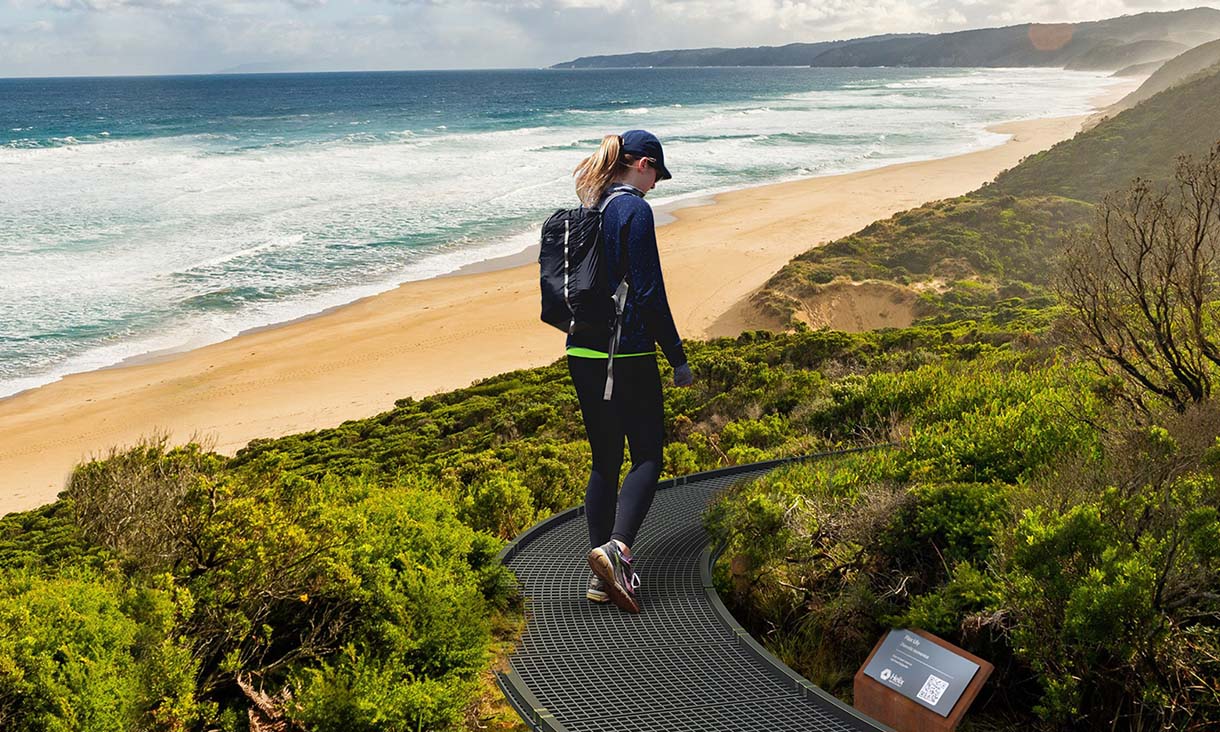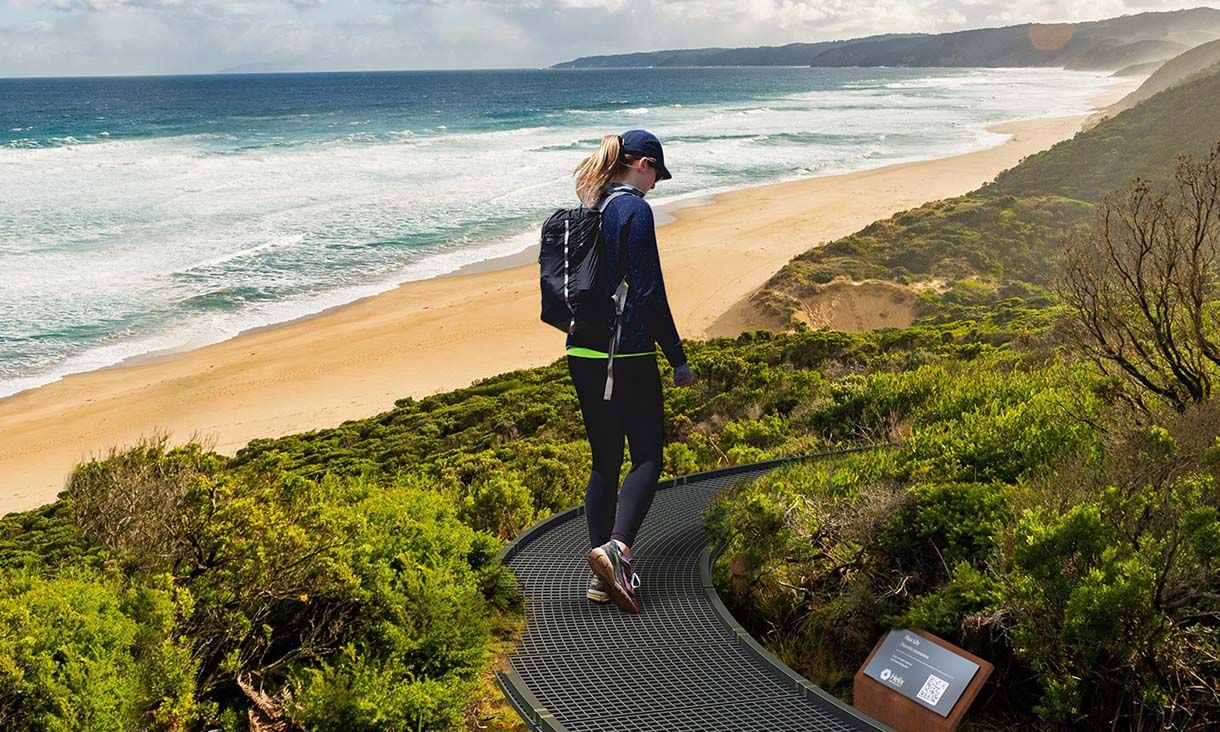Swinburne finalists shine at Premier’s Design Awards

Tread Lightly modular boardwalk, by Anthony Jongen
In summary
- Swinburne’s design excellence features at Premier’s Design Awards
- Six Swinburne design projects achieve finalist status
- Swinburne joins Victorian-led design showcase
Swinburne’s achievements in design excellence featured in the Victorian Premier’s Design Awards. Six projects were awarded finalist status. Joining the celebration of Victorian-led design, Swinburne’s academic, graduate and student projects form an impressive line-up.
Tread Lightly

Tread Lightly modular boardwalk, by Anthony Jongen
By Anthony Jongen, Swinburne Industrial Design graduate, Swinburne School of Design and Architecture, Colac Otway Shire and Surf Coast Shire.
The Tread Lightly project aims to future-proof and protect the natural beauty of the Great Ocean Road in coastal Western Victoria from excessive tourist foot traffic, through the creation of immersive and meandering pathways that minimise impact on natural surroundings.
The modular boardwalk system avoids vegetation damage in delicate ecologies. Vegetation growth is supported underneath the boardwalk with open grating and an overall reduced footprint. Tread Lightly’s non-permanent anchoring system encourages pathways to be re-routed to allow for habitat regeneration while encouraging and sustaining tourism.
Deeper than thirst

Deeper than thirst installation by Alysha Magro
By Alysha Magro, Swinburne Photomedia student and Swinburne School of Design and Architecture.
Deeper than thirst is an immersive and interactive multi-sensory installation that explores the human connection to water. It encourages and stimulates self-reflection and mindfulness, guiding participants to explore their relationship with water, striving to push audience members to become more accountable, conscious and responsible and take action towards conservation. Deeper than thirst shows the immense power and value water has in the existence and function of all life.
Nardoo: The Gallery of Aboriginal Art & Landscape

Nardoo Gallery of Aboriginal Art and Landscape, rendered image by Parisa Bazargani
By Parisa Bazargani, Swinburne School of Design and Architecture.
Nardoo celebrates Indigenous culture and a collective sense of place. The overall form is inspired by the native fern 'Nardoo' and is symbolic to the wetlands of its prior landscape. The gallery narrates the memory of place through Aboriginal art. Its passage curates a journey as a space to be experienced.
The design brief for Nardoo challenges the role of architecture through purposefully engaging in the history and marginalisation of Indigenous Australians in Melbourne's CBD and inner suburbs. The main objective is to propose architectural solutions that 're-frame' the existing margins of Melbourne's CBD through memory architecture, that will impact the local and visiting communities and enhance Indigenous representation through architecture.
Waterfront Mushi

Mushi wetland from mushroom-based biomaterials, photography by Lachlan Outhred.
By Canhui Chen, Daniel Prohasky and Joshua Salisbury-Carter from Swinburne School of Design and Architecture, with Alex Reilly and Alessandro Liuti from Arup, and Nancy Beka and Ben Edwards from Studio Edwards.
Mushi is the first wetland made completely from mushroom-based biomaterials. The structure is biocompatible, taking the form of three floating, interlocking triangular-shaped mycelium structures. Artificial wetlands are typically made from plastics that degrade and contaminate bio-ecologies.
Above the water, Mushi is planted with Australian native species, creating a habitat for birds and insects. Under the water, plant roots absorb excess nitrogen and phosphorous. The Mushi wetland prototype is based on ongoing research in mycelium design at Swinburne in collaboration with Arup and Studio Edwards.
ACMI Lens

ACMI Lens, image supplied by ACMI
By Swinburne Centre for Design Innovation (CDI), Publicis Sapient Australia and the Australian Centre for the Moving Image (ACMI).
The ACMI Lens is a handheld, take-home recyclable device that lets ACMI visitors collect the artworks and objects they discover during their visit. Visitors build their own ACMI collection to take home and watch later to explore the stories and ideas behind their favourite exhibits at the museum, discover new films, TV shows, video games and art. The Lens is helping ACMI to change how visitors think about film, TV and video games.
ACMI's original concept was developed into a prototype by ACMI's experience designer consultants Publicis Sapient. CDI evolved the Lens into a manufacturable and more ecologically sustainable product.
Milkdrop silicone breast pump shield

Milkdrop cushion for breast pumps, image supplied by Milkdrop
By Milkdrop and Swinburne academic researchers, Ravi Bessabava and Daniel Prohasky.
Milkdrop is a soft silicone cushion designed to support the physiology of a baby suckling. It stretches over existing breast pump heads making them softer and more comfortable for women using pumps to express breast milk.
The design of Milkdrop responds to a challenge to change how women feel about breast pumps, by improving both the physical and emotional experience of their use. Milkdrop’s research reveals that over eighty-five per cent of babies have mothers who pump, with potentially millions of women globally experiencing pain and discomfort overlooked by poor design.
Established by the Victorian Government in 1996, the Victorian Premier’s Design Awards program delivers an opportunity to highlight and celebrate local design capability. Entries that demonstrate design excellence are considered for the Victorian Premier’s Design Award finalist accolade. The awards elevate the value of design and the role of professional designers, celebrate Victorian-led design and strive to position Victoria as a design capital.
-
Media Enquiries
Related articles
-

- Technology
- Science
- Engineering
Victorian students drive green energy transition through international hydrogen competition
Swinburne’s KIOSC, in collaboration with Horizon Educational and Gippsland Tech School, co-hosted the Hydrogen Grand Prix in Melbourne.Friday 26 July 2024 -

- Technology
- Health
New MedTechVic prototypes to transform everyday lives of people with a disability
Swinburne’s MedTechVic has revealed three new prototypes designed through the joint Health-led Manufacturing Innovation Program, in partnership with the Australian Medtech Manufacturing Centre and Safer Care Victoria
Friday 19 July 2024 -

- Design
Swinburne alum launches zine celebrating Asian Australian art and identity
Swinburne Graphic Design alum Dan Truong founded HOISZN, a zine publication showcasing Asian Australian artists and their work.
Monday 01 July 2024 -

- Design
Swinburne students shine in lighting design collaboration
Swinburne students collaborated with About Space Lighting, resulting in several student-designed lamps being put into production.
Friday 07 June 2024 -

- Business
- Technology
Swinburne’s Luminate Pitch Night 2024 advances innovative ideas for a better world
Swinburne’s 2024 Luminate Pitch Night showcased market-ready ideas from 10 founders
Wednesday 12 June 2024

